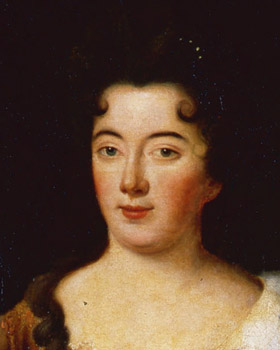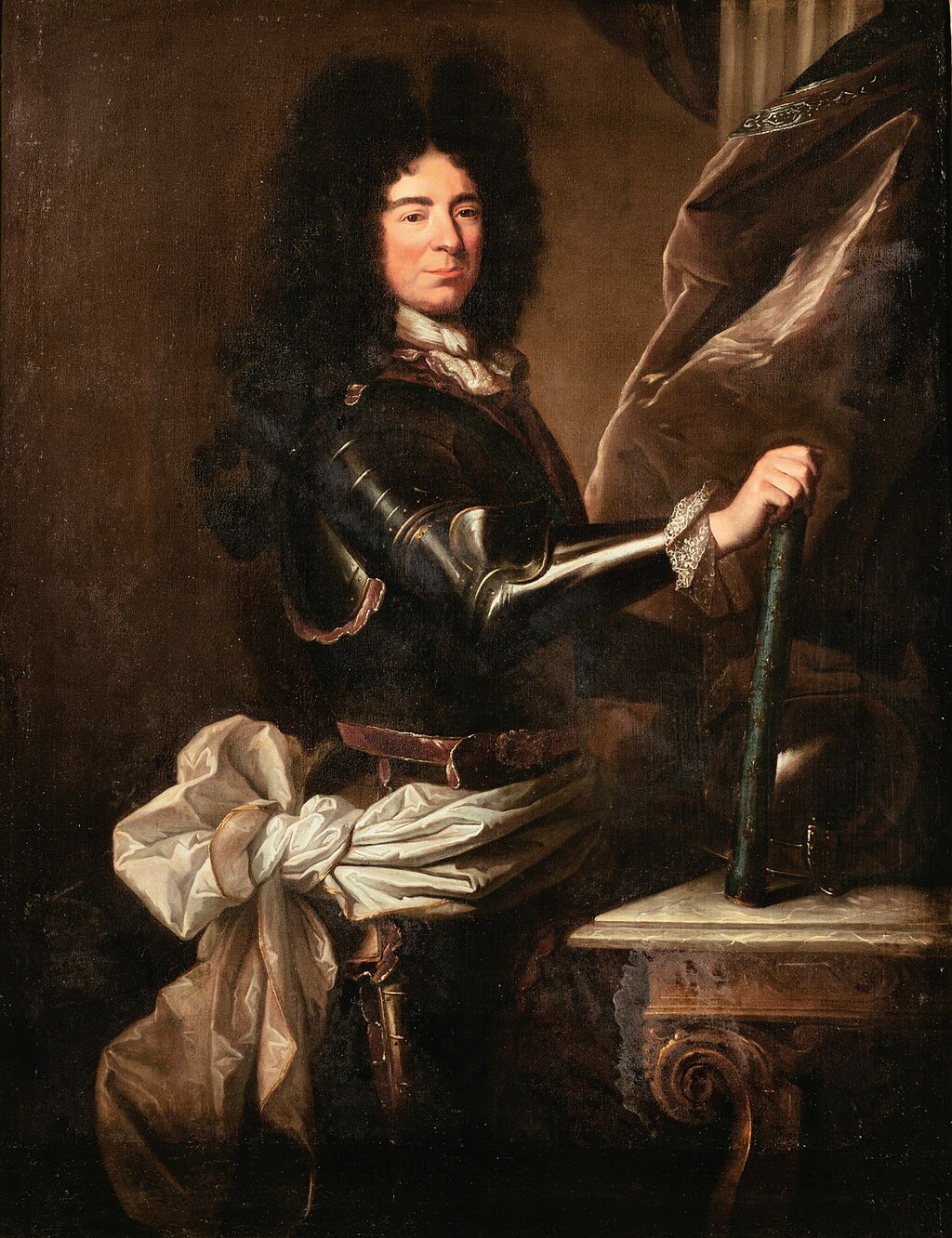Catherine-Charlotte de Gramont was born in 1669 (some sources say 1670) but the exact date is uncertain. She was the eldest daughter of the Duc de Gramont which automatically put her on the path to an excellent marriage. Her childhood was likely spent away from court and she does not appear in public records until 1693. At the age of 24 (or 23) she was married off to the 49-year old Louis-François de Boufflers.
The same year as her marriage, Catherine-Charlotte suddenly fell seriously ill. She had contracted smallpox before the wedding but survived and made it down the aisle. Despite having contracted a disease notorious for leaving its victims scarred, Catherine-Charlotte was still described as being beautiful and "well-made" - her portrait shows her dark, almost black, hair and deep dark eyes. The marriage contract was signed by the king himself and she received a considerable dowry of 400.000 livres, 200.000 livres worth of silver and 200.000 livres worth of land.
 |
| Catherine-Charlotte |
Her new husband was a traditional courtier soldier - he held the rank of Maréchal de France by the time of their marriage which automatically made Catherine-Charlotte the Maréchale de Boufflers. She was officially received at court by Louis XIV and Madame de Maintenon. The king quickly rewarded his numerous militaristic exploits (including five separate wars and at least 12 battles) by elevating him to a dukedom. It should not be disregarded that Catherine-Charlotte's own connections made the elevation more palatable - after all, as the daughter of a duke, it was not unusual for her family to lend their support to her husband's elevation.
Catherine-Charlotte quickly fell pregnant and spent the next ten years given birth to a total of eight children. Sadly, most died in childhood:
- 1694: Louise-Antoinette - became Marquise de Remiencourt
- 1695: Antoinette-Hippolyte - became a nun and died at 22
- 1696: Antoine-Charles - died at 15 from smallpox
- 1698: Charlotte-Julie - also became a nun
- 1700: Louis-François - died at age 6
- 1702: Catherine-Berthe - moved to Spain and became Duchesse de Pepoli as well as Dame d'Honneur to the Spanish queen
- 1704: Marie-Joséphine - became Duchesse d'Alincourt and dame de palais to Marie Leszczynska
- 1706: Joseph-Marie - inherited the dukedom of Boufflers
Just five years later, Catherine-Charlotte found herself a widow when her husband died in 1711. As can be seen above, her children were scattered and five of them she would not have seen again.
She never remarried nor did she particularly need to. She was a duchess, a respectable mother of a new duke and widely respected for her character. There was only one thing that might have obliged her to remarry: money. Despite having had a large fortune, her husband had spent the majority of it, primarily as expenses for his military career. As a result, the king offered him a pension of 12.000 livres per year. Apparently, he had had a taste for doing his duty in splendour with even the Duc de Saint-Simon acknowledging his (expensive) tastes. Amongst others, he kept an open table which was furnished with countless dishes free for everyone. Such things cost money - a lot of money.
 |
| Her husband, Louis-François |
During Louis XIV's reign, Catherine-Charlotte enjoyed the double fortune of being admired herself for her character but also being married to a man who had the king's favour. In 1701 she had even followed her husband to Brussels where her husband held military command. She was received with considerable honour.
As it happens, Catherine-Charlotte was a woman of strong morals which likely helped her secure the position of Premiere Dame d'Honneur to the new queen, Marie Leszczynska, in 1725. Truly, Catherine-Charlotte was ideal for the role. Her reputation was spotless - no rumours of affairs or intrigues - and her rank made her suitable. Furthermore, she was now in her mid-fifties and had experience running her own household.
Yet, if she thought her middle-age would shield her from scandal, she was wrong. It was not her own conduct which brought her embarrassment but rather that of her son. Joseph-Marie was amongst the six gentlemen who were publicly exiled from court due to "indecent behaviour" - a byword for homosexuality in the day. As mentioned, her own behaviour was without scandal. She was nicknamed "Madame Pataclin" which was the name of the head of the Hôtel de Pitié-Salpêtrière - a home for women being punished for prostitution. The reason? She was the head of the queen's household and the king had made it a habit of finding his mistresses there.
Catherine-Charlotte managed the queen's household for a decade before finally resigning. During her tenure, she aided in having her daughter-in-law, Madeleine Angélique de Neufville, placed as dame de Palais to the queen. She had lived at Versailles during her time as Premier Dame - a privilege closely connected with her position. However, once she resigned, she also moved away from court and seemingly voluntarily. The Duc de Luynes reported that in 1737, she had been to court several times but never slept there, even despite the king's attempts at scheduling audiences late, so she would not have to travel back to her own abode. Interestingly, Luynes - one of Marie Leszczynska's closest friends - remarked that the queen received Catherine-Charlotte with politeness but coldly. Perhaps something had happened between them?
A clue is found in other remarks of Luynes' over the years. According to the duke, Marie Leszczynska had once remarked that the Maréchale de Boufflers had prevented those with entrées from entering the queen's apartments between 17.00-19.00 which meant that the queen was effectually trapped with her ladies in her own apartments. Not only does this show how little power the queen had over her own daily life but would also explain the rather frosty reception. The wording suggests a clash of wills between the two women. According to Luynes, the queen had said that Catherine-Charlotte had "fantasized" about thus restricting the queen - the choice of word seems to indicate that the queen clearly opposed the move.
By now, Catherine-Charlotte was nearing her 70th birthday and her health was failing. She died on 25 January 1739, at the age of 69.

You're back! How I miss your blog posts! I am new to this platform but I have much enjoyed reading your posts and learning about Versailles! xx
ReplyDelete